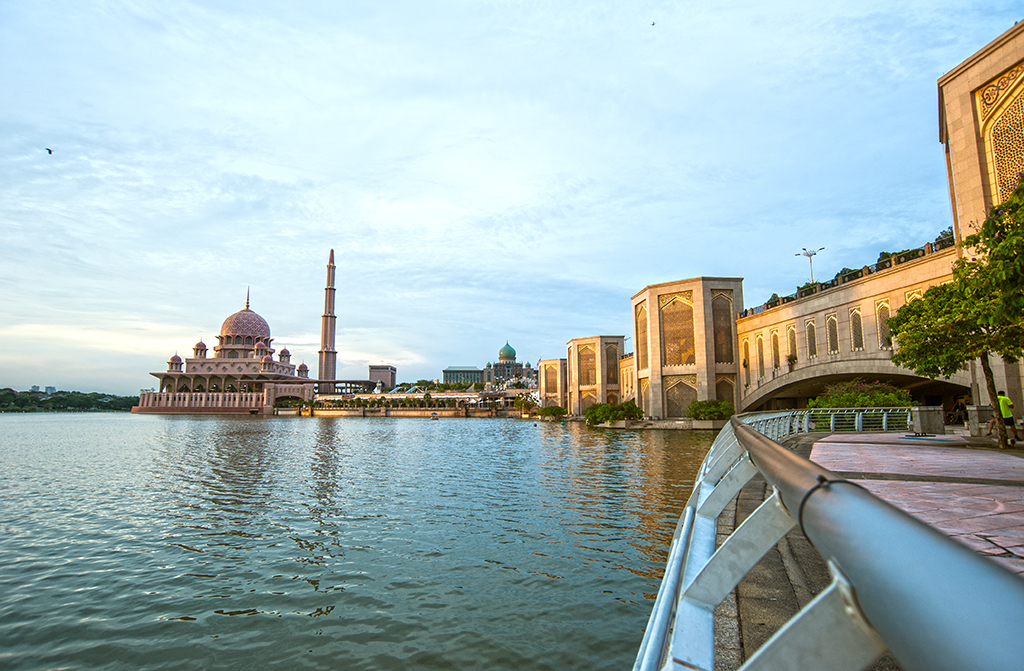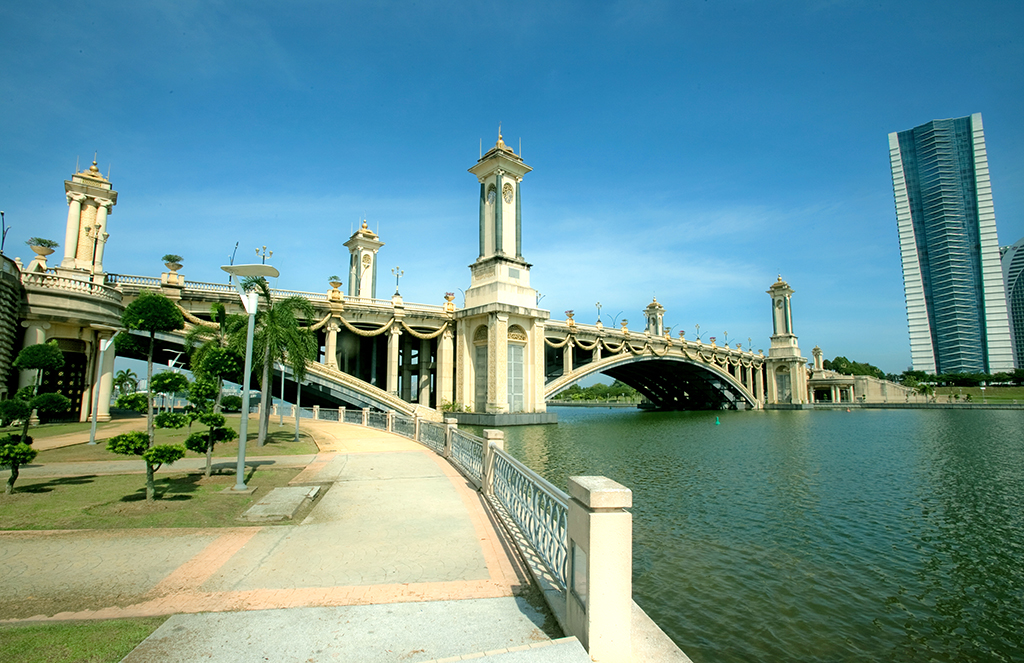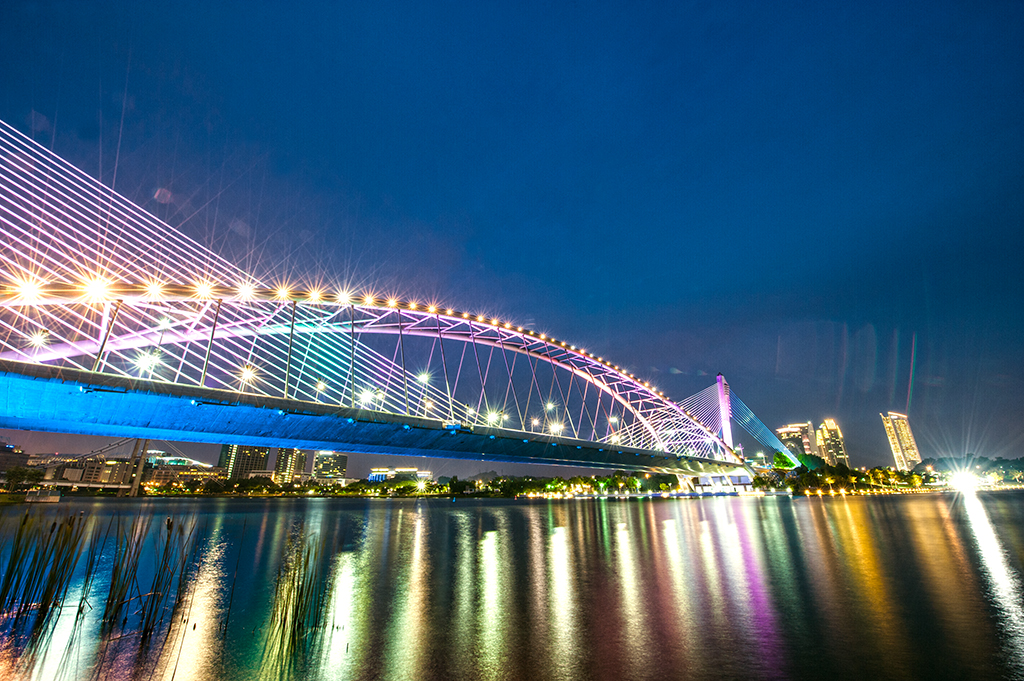Dubbed the futuristic administrative capital of the country, Putrajaya is famous for its strategic town planning, striking architecture, the largest roundabout in the world (at 3.5 km in diameter), as well as scenic man-made lake. It is often regarded as a place for official functions and events.
Lately, though, Putrajaya, located 40 km away from Kuala Lumpur, is gaining popularity among those looking to escape the capital city. Its parks, wetlands, lakes, architecture and peaceful ambience is a magnet for those who love nature, photography enthusiasts, joggers, cyclists and those who indulge in water sport activities.
It is not uncommon to see tourists taking their selfies, or for graduation and wedding pictures to be taken against the beautiful backdrop of Putrajaya.
In addition, more and more events and activities are planned in this administrative capital such as the Royal Floria Putrajaya, which is a flower and garden show much-anticipated by all.
But we’ll let you in on a secret…Putrajaya is even more beautiful by night! The city is, of course, lit up by streetlights and lights from buildings. What’s more enchanting is the lights on several of the iconic bridges of the city.
Yes, the city itself consists of eight signature bridges, i.e. Putra, Seri Perdana, Seri Saujana, Seri Gemilang, Seri Wawasan, Seri Bakti, Seri Bestari and Seri Setia. These bridges are built to link various parts of the city separated by the sprawling network of lakes.
Most of the bridges are lit up in colourful LED lights and high-powered spotlights in the evenings and well into the night. They have become popular sites for wedding photo shoots, and sometimes, are the star of the photographs themselves. When foreign dignitaries are in town, or when it is a national holiday, the night-time ambience of Putrajaya is even more magical with creative and stunning play of lights.
Start your tour of Putrajaya after hours just before sunset. As the sun goes down on the horizon, you’ll be rewarded with a magnificent view: the brilliant rays from the sun cast shadows across the city and the reflections off the lake make the sight of these bridges even more romantic.
Let’s take a look at our top recommendations for Putrajaya bridges by night!
Putra Bridge
One of the main bridges in Putrajaya, the Putra Bridge is 435m long, connecting Precints 1 and 2. The upper level of the bridge forms part of the Boulevard, or the main street in the capital. Its design is inspired by the Islamic architecture of the famous Khaju Bridge in Isfahan, Iran. Its attractions include the four minaret- like piers complete with observation decks that overlook Lake Putrajaya.
Inspired by the design of the Khaju Bridge in Iran, Putra Bridge is the longest of the bridges in Putrajaya at 435 metres. It also makes up the focal point of Putrajaya together with the Putra Mosque in its dusky pink glory and the Putra Square, the hive of activity in Putrajaya.
The bridge connects Precinct 1 (Government Precinct) and Precinct 2 (Mixed Development) on the Core Island. The upper level of the bridge forms part of the Persiaran Perdana (Boulevard). We like to take a sunset drive over the bridge to appreciate the arresting scene of the placid lake with the iconic dome of the Putra Mosque and its surrounds completing the picture.
A special feature of the bridge is its four octagonal towers and its wall of Islamic motifs. The towers are equipped with observation decks which overlook Lake Putrajaya.
Seri Wawasan Bridge
This is one of the main bridges in Putrajaya, connecting Precint 2 to the residential area of Precint 8. The design of this cable-stayed bridge resembles a futuristic ship. Spanning 2.4km, this bridge can accommodate motorised traffic, bicycles and pedestrians. Highly visible even from afar, it has become one of the beautiful icons of Putrajaya.
The Seri Wawasan Bridge, meaning Bridge of Vision, is one of the most beautiful bridges, we feel, in Malaysia. It is the main link between Precincts 2 and 8, featuring a dual three-lane carriageway with a pedestrian walkway and cycling track at the sides.
The bridge spans a length of 240 metres across the Putrajaya Lake. Driving over it, this magnificent cable-styled bridge gives off a sense of strength and purpose. Its elegant lines draw inspiration from the beauty of a sailboat. At night, the whole look of the bridge is transformed with interesting and colorful light play. This much-photographed bridge has become an icon of Putrajaya, it can be easily spotted from various vantage points in the city, even from surrounding areas such as Cyberjaya.
Seri Gemilang Bridge
This ceremonial bridge connects the Heritage Square with the Putrajaya International Convention Centre. Spanning nearly 233m in lenght, the bridge is one of the most popular spots for photography in Putrajaya. The most dominant feature of the bridge is its four distinctive towers which are visible from a distance. Specially designed street lamps light up the bridge at night.
Seri Gemilang Bridge is a rather romantic bridge set in a quieter enclave of Putrajaya. It is a stunning double of Pont Alexandre III that spans the Seine River in Paris, France. As you cross this bridge, you can’t help but notice the intricate mouldings and detailed decorative works inspired by traditional Malay plants and floral motifs. Four main towers with four smaller entrance towers complete this 240-metre long bridge.
The view from this bridge is stunning and we recommend going at sunset to witness the changing colours of the sky reflected on the surface of the lake. You’ll enjoy a stroll on the pedestrian walkway of the bridge, or you can venture down the steps to get to the edge of the lake. From here, take a leisurely walk to explore the peaceful surroundings.
Seri Saujana Bridge
This is another premier bridge in Putrajaya, connecting Precint 4 to Precint 7. This cable-stayed arch bridge has been designed to reflect a transparent, elegant and futuristic structure. With an overall single span of 3km, it is an awesome sight to behold, both day and night.
The Seri Saujana Bridge is one of the signature bridges of Putrajaya. It is the first bridge in the world to successfully combine two different engineering techniques, arch and cable stay. There is no other bridge structure like it in the world! Some have even compared it to the Sydney Harbour Bridge.
Located at the southwest corner of the city, this 300-metre bridge connects Precinct 4 (Commercial Precinct) to Precinct 7. It serves as a grand entrance into Putrajaya for those entering the city from the south on the upgraded B15 road and Kuala Lumpur-Kuala Lumpur International Airport highway.
The night view of Seri Saujana Bridge is even more impressive with mood lighting to enhance the beautiful lines and architecture of the bridge. Like other bridges, it provides a pedestrian walkway and cycle track for public usage.
While the above are our top picks for Putrajaya bridges to visit at night, the administrative capital has four other notable bridges worth visiting as well to enjoy their beautiful architecture and admire the stunning engineering effort.
Seri Perdana Bridge
Located at the South-West of Precinct 1, this bridge connects the Government Precinct to Precincts 8, 9, and 10 across the Putrajaya Lake. Along the bridge are eight pavilions with arches and domed roofs, and these act as viewing decks for pedestrians to pause to take in the magnificent views of the lake.
Compared to the other bridges, the Seri Perdana is simple in design, yet remains elegant with its interesting tile-work in patterned hues of yellow. This continuous beam bridge is 372 metres long and was one of the first bridges to be completed in Putrajaya.
Seri Bakti Bridge
This simple beam bridge is located in the northeast of the city that connects Precinct 1 to the residential area of Precinct 16, which also houses the official residence of the Deputy Prime Minister.
The 270-metre long Seri Bakti Bridge offers a beautiful panoramic view of the surrounding area. Driving along this bridge towards the Government Precinct imparts a sense of purpose and ceremony because the road ahead leads to the Prime Minister’s office and department.
This bridge has dual two-lane carriageways that provide access for vehicles as well as pedestrians and cyclists. The tile work in Islamic motifs and the stylised streetlamps along the length of the bridge give it a unique identity.
Seri Bestari Bridge
The Seri Bestari Bridge lies at the northeast side of Putrajaya, connecting the Core Island to Taman Warisan Pertanian in Precinct 16. It is part of the direct route from the Deputy Prime Minister’s official residence to the Core Island.
This concrete arch system bridge spans 152.6 metres and has dual two-lane carriageways as well as a cycle track cum pedestrian walkway. The footpath bears a tropical theme with its palm trees and plants. Specially-designed lamp posts light up after dark with mood lighting to complete this stunning piece of architecture.
Seri Setia Bridge
Located in the southeast part of the city, the Seri Setia Bridge spans 210 metres across the lake, bridging the commercial district of Precinct 4 to Precinct 19, a high-density residential area with full amenities and facilities.
The designers implemented simple design features to enhance the beauty and functionality of the bridge. For example, the tropical landscaping around the bridge not only serves as an aesthetic element but also protects motorists from the glare of headlights of oncoming traffic.
Another thoughtful design element is the dual three-lane road system constructed on the bridge in anticipation of the heavier traffic in the area. Other enhancements include the tapering of the “legs” supporting the bridge, creating the illusion of an arched hallway beneath the bridge, besides the reference to Islamic identity.








